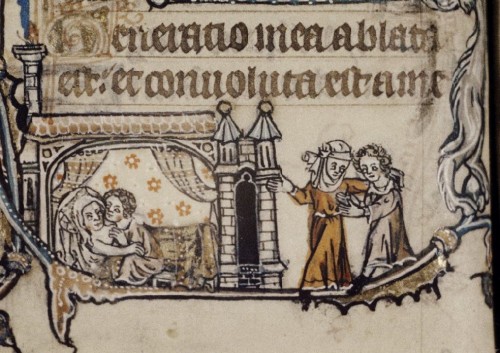Usually, marginalia has nothing to do with the text on the page on which it appears. Of course, this hasn’t stopped the acolytes of Michael Camille from creating elaborate explanations of how it does, but nonetheless, meaningful textual commentary through marginalia is the exception rather than the rule. ((And if you want to fight me on it, I’ll gladly take it outside. Unless you happen to be Michael Camille himself, in which case–Zoinks! A ghost! Run, Scoob! *sounds of feet spinning and legs pumping as runner remains in one place*)) Still, as a textual scholar first, I’m always happy to find exceptions, and here’s a nice bit of jokey commentary from the margin of a 14th-century Flemish Psalter (Bodl. MS Douce 6): ((A manuscript oft featured here, which I sometimes call ‘The Bumper Book of Medieval Monkeys’.))

For the benefit of my non-paleographically trained readers, ((Though given how hard to read captchas have become lately, I think there’s no one left on the Internet not trained in paleography to some extent)) the text directly above our marginal couple is from Isaiah 38:12, from the writings of King Ezechias concerning what he thinks to be his imminent death. It reads, “Generatio me ablata est, et convoluta est a me …” or “My generation is at an end, and is rolled away from me…” In the Bible story, the solution to Ezechias’s sickness is a prayer that brings Isaiah to heal him with a fig plaster, a remedy that affords him an extra fifteen years of life. In the margins, the solution to a failing generation appears to be rather more direct.
If I had to caption it, I’d go with, “Generation at an end, you say? We’ll see about that! M’lady, if you would kindly assist me, I think there’s a little generating left in me yet…”
It should also be noted that there are two couples in the margin there, one pre- and one post- ((Or possibly intra-.)) coitus. Often in medieval art, two images next to each other featuring the same principals are used to demonstrate the passage of time, ((As in modern comic strips, so the idea shouldn’t come as any great surprise.)) so it’s possible we’re watching the successful culmination on the left of a seduction begun on the right.
However, time usually flows left to right ((Or when vertically arranged, top to bottom.)) on manuscript pages, ((And in scrolling art like the Bayeux Tapestry.)) so it’s just as possible that we witness one soon-to-be-frustrated couple about to find out that their first-choice assignation location is already occupied.
Or maybe it’s a fourway in the making between some crazy medieval swingers. You tell me.
And this week I really do mean, you tell me. Vote in the poll below and let me know which you think it is:
Let's get it on, sure, but who's in that contracted "us"?
- One couple, shown pre- and post- (66%, 73 Votes)
- Two couples, about to get freaky-deaky 14th-century style (18%, 20 Votes)
- Two couples, one about to frustrate the other's attempt (15%, 17 Votes)
Total Voters: 110